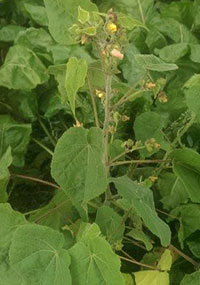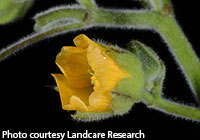Download the velvetleaf farm management factsheet
Background
 Velvetleaf found in Canterbury
Velvetleaf found in Canterbury
Velvetleaf has been discovered in this season's fodder beet crops on a number of properties throughout New Zealand.in Canterbury, Otago, Marlborough and Waikato.
MPI is investigating how this has occurred. It appears likely to have come from imported fodder beet seed.
All farmers who have planted fodder beet seed should check their crops carefully for velvetleaf.signs of velvetleaf. Those who have planted Kyros or Bangor varieties should be particularly vigilant. Potentially contaminated seed has been sold all around New Zealand.
Sightings of this aggressive weed should be reported immediately to MPI on 0800 80 99 66.
Velvetleaf is one of the world's worst cropping weeds, affecting many arable crops by competing for nutrients, space, and water. It is an unwanted organism in New Zealand.Read the latest media release – 29 April 2016
Be on the look out
- Velvetleaf is an annual broad-leaved herb that grows between 1 and 2.5m tall.
- It has buttery-yellow flowers about 3cm across. It flowers from spring through autumn.
- Leaves are large and heart-shaped and are velvety to the touch.
- The plant has distinctive seedpods with 12 to 15 segments in a cup-like ring. Each seedpod is about 2.5cm in diameter.
If you find velvetleaf, photograph it, mark where it is, and call MPI on 0800 80 99 66.
Risk to New Zealand
Velvetleaf is one of the world's worst cropping weeds, affecting many arable crops by competing for nutrients, space, and water. It is an unwanted organism in New Zealand.
Read more about velvetleaf in our pests and diseases database
What's being done
 Velvetleaf seedpod
Velvetleaf seedpod  Velvetleaf flower
Velvetleaf flowerWe know velvetleaf has been present on a small number of properties in the Waikato for a few years, and the regional council is managing it. However, this current fodder beet seed-related situation appears to be recent.
MPI is working with partner organisations to manage velvetleaf. The aim is to find it, contain it, and safely remove any plants found. Your help in finding and reporting this weed will give us the best chance of dealing with it.
Read the latest media release – 29 April 2016
What you can do
 Velvetleaf flower
Velvetleaf flower
Velvetleaf should be easy to spot among this season's fodder beet plantings. It stands well above the growing beet and looks distinctive. However, in some regions this is not the case because the climate is cooler and it doesn’t grow as quick.
If you have planted fodder beet check your fields.
If you find velvetleaf contact MPI on 0800 80 99 66, and then follow these steps:
If the plants have no seeds or if seed pods are green
- Record the location of the plant/s so it is easy to find again for future monitoring.
- Pull out the plant. Bag the full plant – using a large bag (for example fertiliser bag or sack).
- Dispose of the bagged plant/s by deep burial (at least 1m) for example your offal pit.
If the seed pods have turned black
- Carefully place a large bag (like a fertiliser bag or sack) over the plant’s seed capsules and tie the bag tightly around the stem. It is important to make sure all seed heads are contained within the bag.
- Bend the velvetleaf plant in half so that seeds cannot escape out of the neck of the bag.
- Carefully pull out the plant, bag it again, and dispose of it as described above.
- Inspect the rest of your crop to ensure there are no more plants.
Re-inspection this season
- Keep an eye out for any late emerging velvetleaf plants.
- Re-inspect your field before grazing your fodder beet crop even if your property was inspected for velvetleaf this season.
- If you find plants pull them out, double bag them, and dispose of them as described above.
Our factsheet and velvetleaf farm management plan have more information on what action to take.
Find out more
Who to contact
Farmers finding it difficult to deal with the added stress of the velvetleaf incursion are encouraged to call your Rural Support Trust on 0800 787 254 (0800 RURAL HELP) for a free, confidential chat.
MPI and Environment Canterbury, Otago Regional Council, Federated Farmers, Foundation for Arable Research, New Zealand Grain and Seed Trade Association, DairyNZ and Beef+Lamb New Zealand thank you for your help in this important work.
If you have questions about velvetleaf, email info@mpi.govt.nz .
Velvetleaf should be easy to spot among this season's fodder beet plantings. It stands well above the growing beet and looks distinctive.
If you have planted fodder beet, and in particular Kyros or Bangor varieties, check your fields.
If you find velvetleaf:
take a photo of the plant or plants, if possiblemark the location, so it's easy to find againcontact MPI immediately on our pest–and-disease hotline – 0800 80 99 66.
We'll refer your call to the response team, who will:
make arrangements to safely remove any plants so that seed is not spreadinspect the rest of your crop to ensure there are no more plantsprovide advice on management of this pest.
Farm management for properties with velvetleaf
 Velvetleaf seedpod
Velvetleaf seedpod
The response field team will visit properties with velvetleaf infestation and advise on management measures to prevent the pest being moved around the farm or out of the gate. This will include advice on grazing stock.
Containing velvetleaf seed while you wait for technical support
For farmers who have reported suspected velvetleaf to MPI and are concerned about plants seeding while they are waiting on the velvetleaf response team field visit, the following "bag it – bend it" actions could help reduce the risk of seed fall:
If seed heads are present on the plant, carefully place a large bag (like a fertiliser bag or sack or similar) over the seed capsules and flowers on the plant and tie the bag tightly around the stem. It is important to make sure all seed heads are contained within the bag.The velvetleaf plant should then be bent in half so that seeds cannot escape out of the neck of the bag. The plant should remain in the ground until field staff visit.
MPI and Environment Canterbury, Otago Regional Council, Federated Farmers, Foundation for Arable Research, New Zealand Grain and Seed Trade Association, DairyNZ and Beef+Lamb New Zealand thank you for your help in this important work.
Read MPI's velvetleaf farm management plan
Printed information
Download and print our A4 factsheetDownload and print our A4 posterDownload and print our factsheet on velvetleaf farm management
Who to contact
Farmers finding it difficult to deal with the added stress of the velvetleaf incursion are encouraged to call your Rural Support Trust on 0800 787 254 (0800 RURAL HELP) for a free, confidential chat.
If you have questions about velvetleaf, email info@mpi.govt.nz .



















